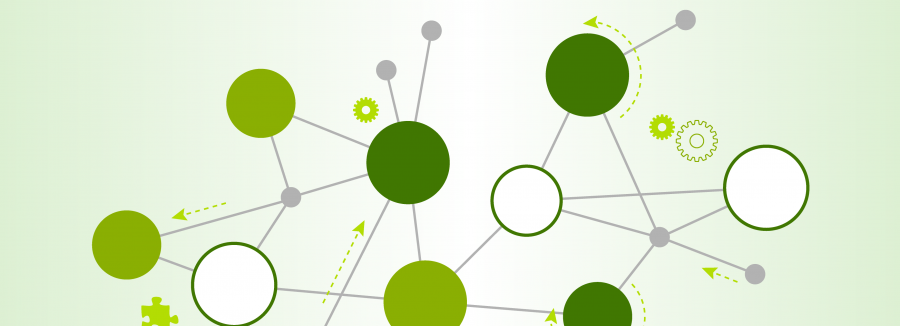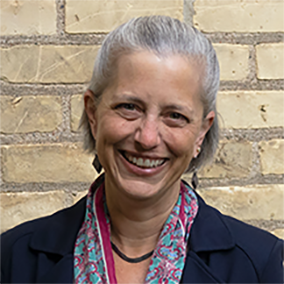In this interview, Dr. Elizabeth Borer explains how an innovative modeling approach developed by her SESYNC project team helped to bridge the divide between ecosystem ecology and disease ecology and further their research.

Science is about discovering the unknown, and SESYNC’s pursuit on Microbial disease dynamics, ecosystem processes, and human eutrophication of the environment straddles the conceptual intersection of disease and ecosystem ecology in a groundbreaking way. Dr. Elizabeth Borer, Professor at the University of Minnesota, led this project in collaboration with an interdisciplinary team of researchers.

Though she is a highly accomplished scholar, Borer (pictured at left) describes herself as, “never being an expert and being ok with that.” Trained as a classical ecologist, she has always found herself intrigued by how the subdisciplines in ecology relate to one another and how inquiry at these intersections can spark exciting research questions. One of those questions was the catalyst for Borer’s research team at SESYNC to launch a novel project that built bridges between disciplines by asking: ‘Do pathogens interact with ecosystem processes to influence environmental outcomes?’ An integral part of answering this question is understanding how ecosystem and disease ecologists approach their study of the environment.
Ecosystem ecologists see nature from the perspective of stocks, flows, and transformations of elements. Within this paradigm, plants represent stores of elements such as carbon and nitrogen that are transformed chemically before they move into the atmosphere or soil following decomposition. Disease ecologists, on the other hand, see nature from the perspective of organisms—in this case plants that serve as hosts or pathogens that have the potential to infect plants. Within the plant, the pathogens reproduce and spread to infect a new host. Infection in plants however may change the stocks, flows, and transformations of elements. Despite this fact, disease ecologists and ecosystem ecologists have primarily worked separately—missing out on the potential to examine the undiscovered feedbacks and effects of pathogen invasion on ecosystem function and dynamics.
Borer’s team set out to integrate these different perspectives and methods from disease ecology with those from ecosystem ecology. Their research redefines traditional disciplinary lineages in favor of an interdisciplinary perspective that interrogates questions that haven’t been thought about before. Because disease and ecosystem ecology are defined by different theories and epistemologies, the researchers bridged them by building new dynamic models. Borer emphasizes that “disease ecologists and ecosystems ecologists think fundamentally differently, so triangulating between the math associated with disease and ecosystem approaches was really exciting but definitely challenging.”
The team’s recent publication on “Elements of Disease in a Changing World: Modeling Feedbacks between Infectious Disease and Ecosystems” published in Ecology Letters, outlines their endeavor to model environmental dynamics at this intersection. As Borer explains, their Ecosystem-Disease (ED) model “looks at the consequences of feedbacks between environmental change and disease in plants and algae,” which had long been overlooked. The development of a modeling framework to examine this relationship has implications to inform decisions and management of ecosystem services and products that humans rely on.
Borer’s team had the difficult task of imagining new ways to integrate disease and ecosystem science in a mathematical model that captures the methodologies and complex system dynamics across disease and ecosystem ecology. After extensive group discussion, Borer recalls the group creating, “a big diagram of the biology and the linkages—the interactions that we saw in this larger biological and socio-ecological system.” This diagram helped the group identify key areas of focus and linkages to be translated into a mathematical basis for their ED model. Math functioned as a logical and unifying language among the team, which included biologists from a range of subdisciplines, disease and ecosystem ecologists, and mathematicians.

For the math model to work at this unexplored intersection, the group needed to create a “common currency” that was relevant across disease and ecosystem ecology. They chose to use the shared currency of elements that specifically track organic and inorganic nitrogen and primary producer biomass (or carbon) in vegetation, litter, and soil.1 Using the elemental perspective, which is more akin to ecosystem science, allowed them to model the interactions and feedbacks between nutrient supply and recycling with disease. Ultimately, this informed the model’s understanding of changing environmental conditions and created an innovative modeling framework.
To achieve this high level of disciplinary integration in the model, the group’s diverse composition was key. They brought together distinct yet complementary perspectives to push the project forward. While working together, the team spent a lot of time teaching each other about their disciplinary backgrounds, experiences, and vocabulary. Borer described the importance of setting a collaborative tone in the group to create the welcoming space needed to navigate the unknown. “I try to set a tone of humor and humility in a group. I’m pretty careful about setting a tone of just letting it all hang out there,” Borer said. This allowed the group to feel comfortable to move outside of their disciplinary paradigms and operate in the learning mode needed to transverse a cutting-edge research question.
Now that their SESYNC pursuit has ended, the research team is continuing to work together to expand the scope of their model to have it include more biologically realistic details to enrich the model’s outputs. The group has also discussed moving forward with experimental tests of the dynamics that were revealed in the model. These efforts are helping to inform future “inquiry to include thinking about disease in planning for ecosystem management and management of ecosystem services,” said Borer.
The ED model that was developed through this SESYNC pursuit offers a portal into exploring the rich relationships and questions that exist at the convergence of fields that hadn’t been recognized before. Borer’s advice to scholars looking to embark on this type of bridge-building research is all about “embracing ignorance and just being excited to learn, being ready to teach, but especially being ready to learn.” This willingness to dive into the unknown is what propelled this research team forward, but their collaborative spirit is what fueled a truly groundbreaking research project.
1 Elizabeth T. Borer et al., “Elements of Disease in a Changing World: Modelling Feedbacks between Infectious Disease and Ecosystems,” Ecology Letters vol. 24, no. 1 (2020): 6–19, https://doi.org/10.1111/ele.13617.
To view in your browser and/or download the article, click on the PDF below.